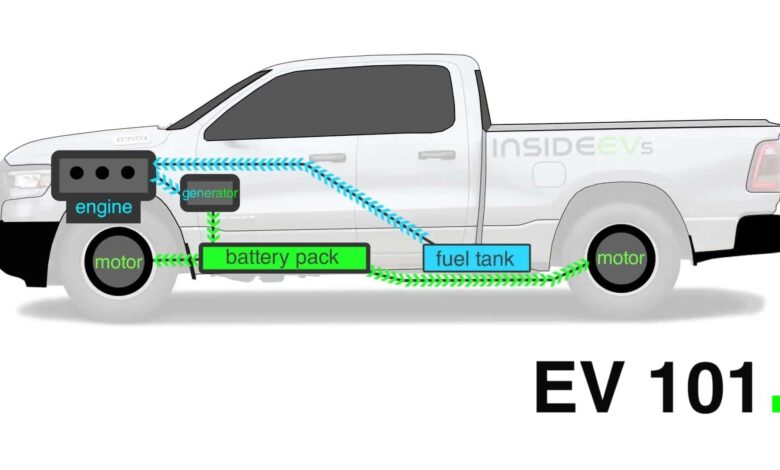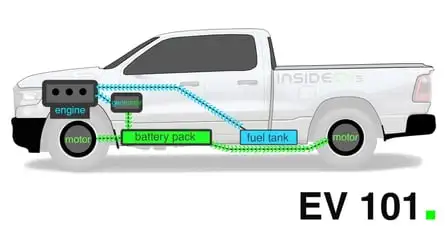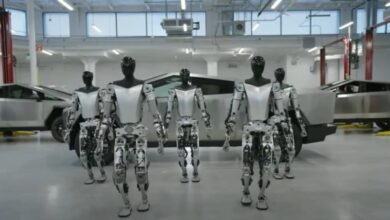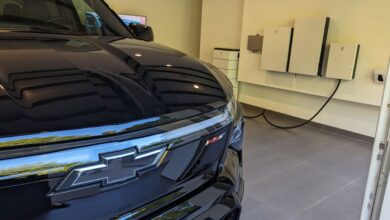How Does An Extended-Range Electric Vehicle Work?

Also known as range extenders, or EREVs for short, these electric vehicles trade some battery capacity for an onboard generator.

One of electric vehicles’ biggest problems is their battery pack. It is big, heavy and expensive, and its materials are sourced from distant parts of the globe, leaving a big carbon footprint. That’s why some manufacturers have put smaller batteries in their EVs and supplemented the difference with an onboard generator that burns fuel to create electrons and provide additional range.
These electric vehicles that also have some kind of engine that spins a generator to create additional power are called range extenders or extended-range EVs (shortened as EREVs or, more rarely, E-REVs). If you want to get nitpicky, EREVs are not pure EVs since they still use fossil fuel to make electricity when the juice in the battery is running low—but they aren’t plug-in hybrids (PHEVs) either.
The chassis for the 2025 Ram 1500 Ramcharger truck. You can see the lithium-ion battery in the floor, the V6 engine up front, and front and rear dual electric motors. The engine only serves to power the battery, not drive the wheels.
Unlike PHEVs, whose engines not only help create electricity but also directly drive the wheels, range extenders’ engines only provide power to the generator to produce energy. True range extenders are rare, and even some vehicles that are widely known to fall into this category (like the Chevrolet Volt) would more accurately be classified as PHEVs since their combustion engine does have a mechanical link to the wheels.
For us to define a vehicle as an extended-range EV, there needs to be no way for the engine to connect to the wheels.
How Are EREVs And PHEVs Different?
EREVs fall into the category of series hybrids, which means they propel themselves solely with electric power, and when that runs out, the generator kicks in to replenish it to extend the range. This has the advantage of allowing the engine to run at a constant rpm and stay in the optimum power band to maximize efficiency so that it uses as little fuel as possible while it’s on generator duty.
Series hybrids are not common in passenger vehicles (they’re more widespread in railway locomotives), and only a handful actually meet the criteria to be called EREVs: the original Fisker Karma, the BMW i3 REx, the Mazda MX-30 R-EV, and the most recent addition to this very short list is the new Ram 1500 Ramcharger. The failed Via Vtrux is also a range extender.
Models like the Chevrolet Volt and Mitsubishi Outlander PHEV mostly drive on electricity, but they can get their combustion engines to power the wheels in certain situations, so they must be mentioned with an asterisk—they can operate as both series and parallel hybrids.
2025 Ram 1500 Ramcharger.
The difference between EREVs and PHEVs stems from the fact that in the latter, it’s the combustion engine that provides most of the propulsion. In a PHEV, even if you have plenty of juice in the battery, if you floor the go pedal, asking it to give all the performance it’s got, it will have no choice but to wake up the engine.
In an EREV, when you accelerate hard, even though you may hear the generator wake up and increase its revs above where they usually sit under normal driving conditions, all that’s powering you forward are electric motors.
The engine itself is of a larger displacement in PHEVs (as well as in the Volt and Outlander PHEV), while the generator in true range extenders is way smaller—the interesting single-rotor Wankel that puts electricity back into the MX-30 R-EV’s 17.8 kWh battery pack displaces just 830 cubic centimeters, while the motorcycle engine used as a generator in the i3 REx is even smaller at 647 cc.
The gauge cluster on the Mazda MX-30 R-EV.
The Ramcharger is an exception with its large 3.6-liter Pentastar V6 generator, as is the Fisker Karma, which runs a 2.4-liter, four-cylinder GM Ecotec engine as its generator.
The transmission is another difference between EREVs and PHEVs. In most PHEVs, the electric motor is usually embedded into the gearbox, and if you pay attention, you can actually hear and sense the gear shifts even in electric mode—this is most evident in the new line of Mazda plug-in hybrids like the CX-90 PHEV, where you can even rev the electric motor when in neutral like you would a combustion engine.
In EREVs, the transmission is much simpler and it’s the same kind of simple reduction gear mechanism that you find in most pure electric vehicles (except the Porsche Taycan and Audi E-Tron GT, which have a two-speed gearbox for the rear motor). This means that when you drive an EREV on electric power without the generator powered on, it will feel completely smooth and seamless, just like any EV.
Why Aren’t There More EREVs?
The big reason why there aren’t more extended-range EVs is complexity. Automakers like to play it safe, so they’ve either electrified their existing combustion cars and turned them into hybrids or plug-in hybrids, or they just made pure electric vehicles. Adding a generator to an EV is harder than it sounds, especially if you’re a large carmaker that tightly controls budgets and needs a lot of time to develop, test and produce completely new technical solutions.
The other downside is, of course, emissions. Pure EVs create no tailpipe emissions, but EREVS do from their internal combustion engines, even if it is vastly less than a purely gasoline or diesel vehicle.
Having said that, we do expect more EREVs popping up over the next decade, though, if uneven EV growth persists across the world. The Ramcharger is a big one; so are similar applications of that idea for Jeep. Mercedes-Benz is cooking some up as well. It remains to be seen how these vehicles perform in terms of emissions versus their gas-powered counterparts.
The battery pack is the single most expensive (and largest) component that goes into making an EV and halving its size would make it more affordable. Adding a small ICE-powered generator to compensate for the lost range sounds like a good way to go. It would also alleviate the range anxiety that some EV drivers still experience to this day (even though there’s already a good selection of affordable EVs with at least 250 miles of range.)
Knowing that they could just pull into a gas station and fill up would definitely offer peace of mind, although it would not be the ideal way to run an EREV. It is far better to keep a range extender’s engine off most of the time, charge it when needed, and just run it on electrons.
Even with a smaller battery and about half the electric range of a pure EV with a larger battery, an EREV should still provide sufficient range for the average daily commute without having to use the generator.
But there’s a learning curve here too for new buyers. New owners may struggle with charging them, as they often have with PHEVs. In the end, they may get worse gas mileage than a comparable pure ICE vehicle if they don’t operate these cars as designed.
Read more



